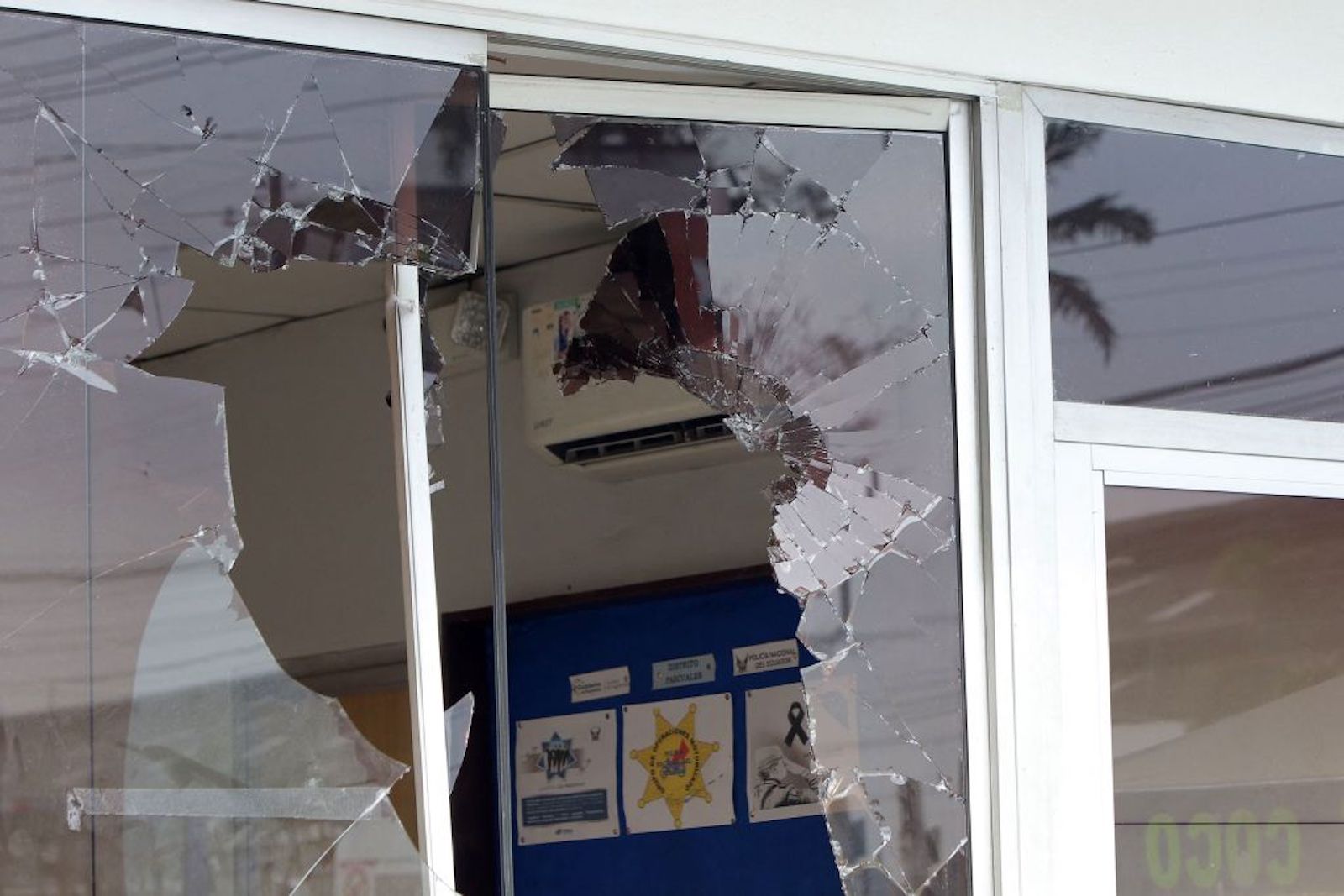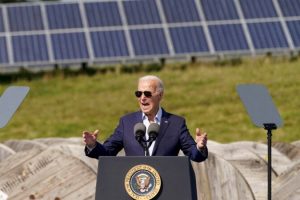( Spanish) — Ecuador is currently experiencing a wave of violence in the provinces of Guayas and Esmeraldas that led the country’s president, Guillermo Lasso, to decree a state of emergency and a curfew in an attempt to contain the violence.
Hours of terror were experienced in Guayaquil in the early hours of this Tuesday, November 1, when the Police reported several attacks with explosives against police units. The balance of the attacks until this Thursday is at least five dead policemen and four more wounded.
The government said this week’s wave of violence is a reaction by drug trafficking groups to operations in the country’s prisons.
“Insecurity is the main problem in our country today,” Ecuador’s Minister of Government, Francisco Jiménez Sánchez, said in Conclusions of en Español. “I believe that there are no major questions about that because the figures say so, people say it on the street, we are constantly in contact with that reality.”
This is what we know about the public order situation in Ecuador.
Image of the broken window of a Community Police Unit (UPC) post taken after an attack with explosives in Guamote, Guayaquil, Ecuador, on November 1, 2022. (Credit: GERARDO MENOSCAL/AFP via Getty Images)
Why did this recent wave of violence start?
A series of attacks with explosives and car bombs were recorded by the Ecuadorian Police against police units, this Tuesday, at different points in Guayas and Esmeraldas after the Service for the Attention of Persons Deprived of Liberty (SNAI) began transfer operations of dozens of prisoners from the Litoral Penitentiary, the largest prison in Ecuador, to other penitentiary centers.
The transfer of at least a thousand prisoners from the Guayaquil prison to two other detention centers provoked more than 18 attacks on the police with weapons and shots.
Police authorities confirmed the death of 5 agents during an attack with firearms on a patrol car by criminals. In addition, they reported that they arrested those presumed responsible for these events without giving more details about the number of suspects that are in their custody.
The prisoner transfers are an attempt by authorities to reduce prison overcrowding and improve prison conditions, according to the SNAI.
Ecuador’s Defense Minister, Luis Lara, said Wednesday that the violence experienced in recent hours in the provinces of Guayas and Esmeraldas is associated with drug trafficking and organized crime.
From Guayaquil, where the Unified Command Post (PMU) was installed, Lara said that the attacks are due to a reaction to the “firm decision of the National Government to retake control of the prisons and eradicate the drug business in the country.” .
Lara said that so far 1,400 elements of the Armed Forces have been deployed in Guayaquil and that more will be added between this Wednesday and Thursday.

Forensic medicine personnel move the body of an inmate at the last fence of the Penitenciaría del Litoral in Guayaquil, Ecuador, on November 2, 2022. Police and soldiers patrolled terror-stricken streets in two Ecuadorian cities on Wednesday after a series of attacks attributed to organized crime groups waging a deadly war on drugs. (Credit: MARCOS PIN/AFP via Getty Images)
The attacks in Guayaquil and Esmeraldas
The authorities reported in the early hours of this Tuesday moments of terror when several attacks with explosives were perpetrated in Guayaquil, which caused damage to Community Police Units in the Orquídeas, Socio Vivienda and Pascuales sectors.
The explosion of several vehicles located in the vicinity of gas stations on the road to Pascuales and the Perimetral in the north of Guayaquil is also being investigated, an event that left no injuries; as well as another attack next to the Municipal Terrestrial Terminal of Pascuales around 2:58 in the morning in the urban bus area. There was a detonation of a suspected car bomb, reported the Guayaquil Transport Terminal.
Meanwhile, in Esmeraldas, three detonations were registered, two through car bombs and one in the surroundings of the Community Police Unit. Police Commander Fausto Salinas pointed out that the wave of attacks began after an alert of threats from prisons due to the transfer of dozens of inmates to other prisons in the country.

Families of inmates protest against the transfer of their relatives to other prisons outside the Penitenciaría del Litoral in Guayaquil, Ecuador, on November 1, 2022. MARCOS PIN/AFP via Getty Images)
The explosions in Esmeraldas occurred just hours after the local police reported to the press the appearance of two decapitated bodies this Monday morning on the pedestrian bridge in the La Inmaculada area, in the center of Esmeraldas, and the discovery of two heads in the neighborhood of 50 houses, which they presume, would be from the bodies. The case remains under investigation.
Meanwhile, during the transfer of prisoners to other prisons in the country, the SNAI confirmed that eight prison security agents were held by inmates from the Esmeraldas prison and were finally released.
The Ecuadorian Ministry of the Interior reported this Tuesday that after the attacks perpetrated in Guayaquil and Esmeraldas, raids were carried out in which 28 detainees were reported and the seizure of eight firearms, 227 ammunition, three rifles, thirteen cell phones, a motorcycle, a vehicle , three police garments, 600 envelopes of controlled substances, three pistols, 60 detonating capsules and eight sticks of dynamite.
Lasso orders state of emergency and curfew to contain violence
Faced with the wave of violence, President Guillermo Lasso declared a state of emergency in Esmeraldas and Guayaquil and the curfew from 9 at night until 5 in the morning in these regions plagued by violence.
The curfew will run from November 1 to December 16. During curfew hours you will not be able to circulate.
But critics of these measures have pointed to the large number of states of exception that have been signed both in the Lasso government and in that of his predecessor, Lenín Moreno, when prison massacres have been reported or when there are public attacks. This generates discomfort and concern because in the end they do not completely solve the acts of violence and it is not known to what extent prison violence can be contained with these states of exception.
Meanwhile, the president said Wednesday that the attacks were “deliberate” “terrorist attacks” orchestrated by drug traffickers, who sought to generate fear and chaos, “but they did not succeed,” he said on national television.
“We are deploying all the necessary actions to confront this enemy: organized crime and drug trafficking… to ‘recover peace,'” he added.
According to the president, the authorities have seized more than 300 tons of drugs, have dismantled drug and extortion gangs through operations in prisons and streets that resulted in the capture of 53 criminals, who will be made available to the judicial authorities “so that pay”, lasso said.
What the state of exception means
According to declaration of a state of exception, this measure allows:
- The mobilization of the armed forces “and their participation in the restoration of public order” to strengthen internal control in order to “guarantee the integrity and peaceful coexistence of citizens.”
- Rights will be limited, in states where there is a state of exception, such as freedom of association and assembly, in order to “limit the spread of violent actions,” says the decree.
- The measure also suspends the inviolability of the home and the inviolability of correspondence sent or received in the states in question.
Violence in the country’s prisons
Ecuador’s prison system has faced a series of structural problems for decades, but violence in detention centers has skyrocketed since 2020, when at least 400 murders have been reported, which has generated concern from the United Nations and the Inter-American Commission on Human Rights, reported Reuters.
The ongoing series of riots and other incidents was initially sparked by the murder of the suspected leader of the Rasquina gang, prison authorities say, according to Reuters, sparking a power struggle within the Los Choneros gang, considered one of the most powerful in the prison system.
Some 10 gangs operate in Ecuador’s 36 detention centers, according to the SNAI, and count some 11,000 of the country’s 33,500 prisoners among their members.
Meanwhile, the United Nations has reported that Ecuador’s prison population has tripled in the last 13 years. And President Lasso has released some people early to ease overcrowding, which has reached 36% over capacity in recent years, according to Reuters.
The president has promised to train more guards, but his government failed to negotiate with prison gangs and some officials have been accused of corruption, says Reuters.
The SNAI prison agency is working to install modern monitoring systems and improve conditions, an agency memo seen by Reuters showed.














